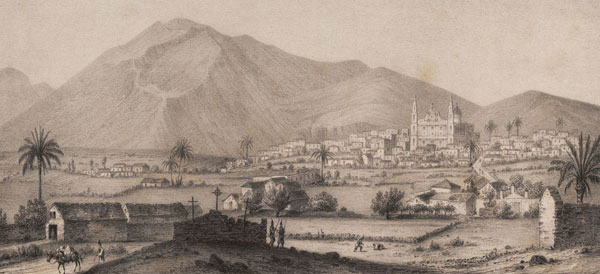A painted cave in Gáldar
The principal cave was nearly circular, and was, where we could measure it, eighteen feet in diameter. It is possible that the walls sloped upwards, and that the bottom, if it had been clear of rubbish, it would have been larger. Another cave, to the right of this one, is also painted. The painting is done in sections, generally running round the cave in widths of ten inches.
The ceiling is in squares; like a chess-board, white lines being drawn across the squares; the come red circles of two rings, the outer being ten inches in diameter; next are triangles, that fit into each other, the base of one being beside the apex of the other; these are painted alternately black and red. The row beneath is a double-lined zigzag, the points or elbows being at top and bottom. Between the lines the cave is painted red, but the spaces at the bottom are white. Below these are plain squares divided by white lines; the squares are alternately red and black.
 Gáldar, 1839
Two more designs we noticed, one in squares bisected at right angles, the upper half being black and the lower red; and on a stone we saw red lines like inverted V’s, on above the other. There are no doubt other designs down to the floor, but we could not of course see them. The temperature and the foul air at last became so unbearable, that we were forced to beat a retreat to avoid suffocation. We had candles inside to see by, for sufficient daylight could not penetrate. The principal feeling with which I left the cave was one of indignation that there was no one with public spirit enough to preserve this ancient and historical relic for posterity.
Gáldar, 1839
Two more designs we noticed, one in squares bisected at right angles, the upper half being black and the lower red; and on a stone we saw red lines like inverted V’s, on above the other. There are no doubt other designs down to the floor, but we could not of course see them. The temperature and the foul air at last became so unbearable, that we were forced to beat a retreat to avoid suffocation. We had candles inside to see by, for sufficient daylight could not penetrate. The principal feeling with which I left the cave was one of indignation that there was no one with public spirit enough to preserve this ancient and historical relic for posterity.
Olivia Stone, Tenerife and its six satellites (1887)





